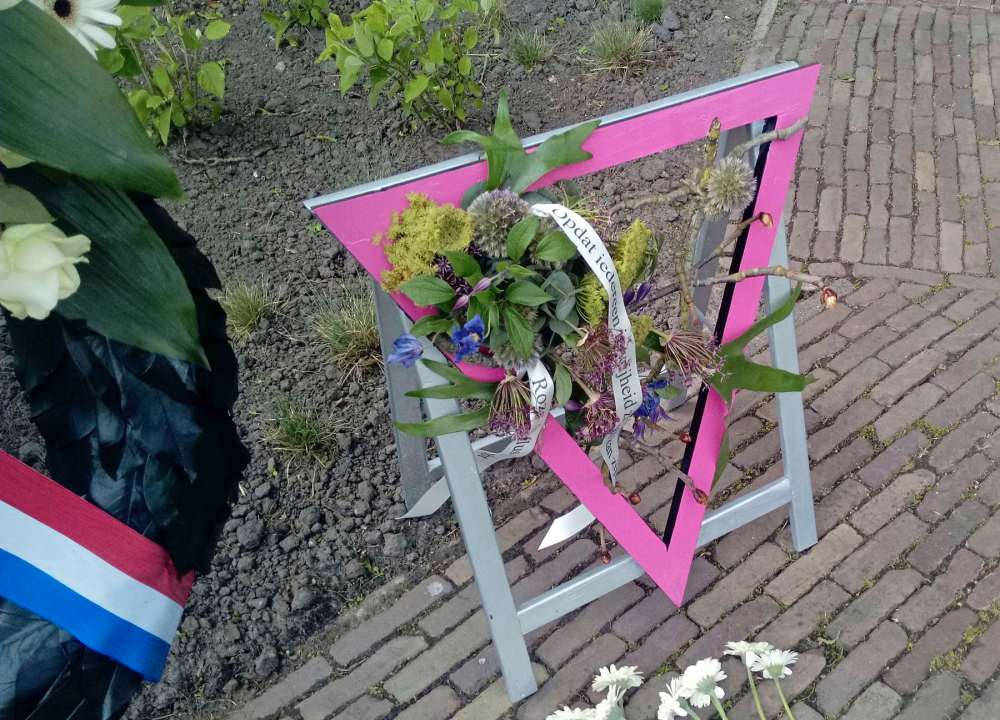Remembering the pink triangle
Advertisement
Hey there, time traveller!
This article was published 07/02/2020 (2098 days ago), so information in it may no longer be current.
Valentine’s Day is a day of love. For others, Feb. 14 is also a day of remembrance — Pink Triangle Day.

To understand what this day means, one must journey back 80 years, when the pink triangle was a symbol used in the imprisonment of LGBT+ individuals during the Holocaust.The symbol’s transformation, from one of oppression to one of inclusion, is a testament to decades of work by those in the LGBT+ community.
According to the Jewish Virtual Library (JVL), there was a significant LGBT+ rights movement in Germany near the end of the First World War under the leadership of Magnus Hirschfeld and his organization, the Scientific Humanitarian Committee.
The primary goal of the movement was to repeal the law known as Paragraph 175 (established in 1871), which criminalized homosexuality in Germany.
Though the law was not repealed, a climate perceived to be slightly more sympathetic allowed LGBT+ meeting places to be established, books, articles and films published and released and such topics could be more openly discussed.
It was short lived— in the mid-1920s, the government attempted to counteract this social change by enforcing anti-LGBT+ laws more enthusiastically and passing more restrictive legislation. At this time, the Nazi Party also asserted its anti-Semitic and anti-LGBT+ view that Jewish people were leading a movement to undermine the morality of the German people.
In 1933, the Nazis officially took power in Germany. A purge of LGBT+ meeting spaces, publications and organized groups began in late February of that year. Groups were banned, meeting spaces raided and shut down and Paragraph 175 (which was expanded in 1935) was enforced with a new strictness and vigour. With the establishment of the Dachau concentration camp in March, the Nazis began imprisoning people in camps and categorizing them using various badges.
These badges allowed the Schutzstaffel (SS), to easily identify a person’s alleged grounds for incarceration. Gay men, and those the Nazis mislabelled as such (including bisexual men and transgender women), were made to wear a pink, inverted triangle.
Personal accounts from gay Holocaust survivor Pierre Seele tell that LGBT+ prisoners were considered to be of the lowest caste. They were disproportionately used for torturous Nazi experiments, including attempts to “cure” them of their identities, and other prisoners would attack them.
It’s unknown how many LGBT+ people were arrested, officially charged, sent to camps, and/or killed. Richard Plant, author of The Pink Triangle: The Nazi War Against Homosexuals, estimates that 50,000 to 63,000 people were convicted of homosexuality between 1933 and 1944. The JVL says the death rates for those convicted for being gay were three to four times higher than those of other non-Jewish prisoners.
As concentration camps were liberated at the end of WWII, many of those detained for being gay — or the suspicion thereof — were simply re-incarcerated. At the time, homosexuality was still illegal in Canada, the United States and most other major nations. The Nuremberg War Crimes Trials also failed to address the plight of LGBT+ prisoners with the same seriousness as those of other victims.
The 1970s saw the LGBT+ community in North America and Western Europe begin to take ownership of the pink triangle. Liberation advocates began to use the symbol in their movements to raise awareness of LGBT+ persecution during the Holocaust, as a memorial and to protest ongoing discrimination.
By the 1980s, the pink triangle saw much wider usage. It was incorporated into memorials, logos and was strengthened as a positive symbol for the community. During this period, the un-inverted pink triangle was officially adopted as a “reversal” of its usage by the Nazis.
By the 1990s, a pink triangle enclosed with a green circle was officially being used as a symbol to identify safe spaces for LGBT+ people, such as general meeting spaces, as well as workplaces and schools. In 1994, Paragraph 175 was finally repealed in Germany. Then, in 1995, following a decade of campaigning, a pink triangle memorial was installed at the Dachau Memorial Museum to commemorate the suffering of LGBT+ Holocaust victims.
Today, the pink triangle is the second most popular symbol of positivity within the LGBT+ community.Officially established in 1979 by the Canadian Lesbian & Gay Rights Coalition, Pink Triangle Day is observed annually on Feb. 14 by LGBT+ people, groups and human rights advocates — such as the Nova Scotia Rainbow Action Project —as a day to remember and celebrate. However, it has not been nationally recognized by the Government of Canada.
Cassandra Wehrhahn (they/them/their) is a reporter/photographer for the Neepawa Banner & Press.




